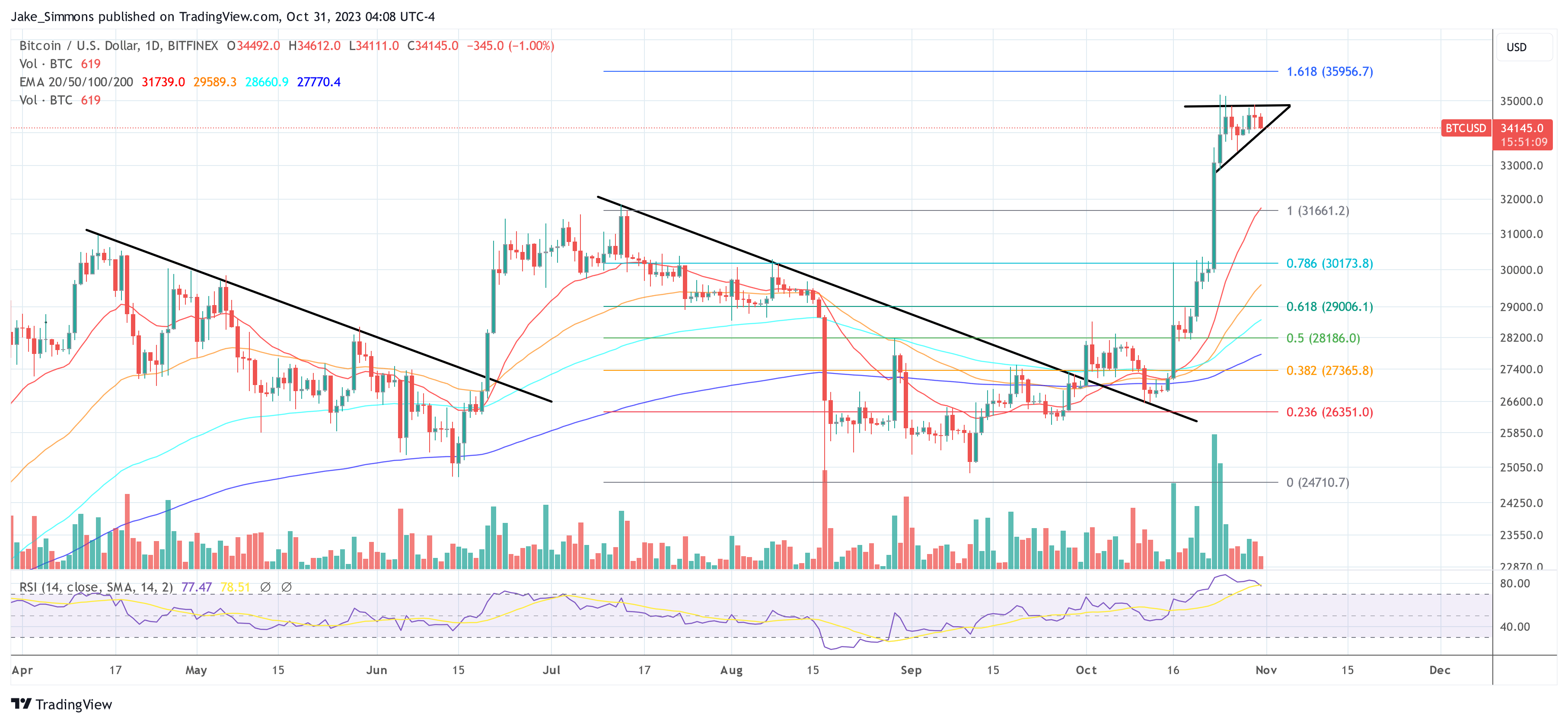
The result of today’s Federal Reserve minutes, Bitcoin miners’ robustness and increasing stablecoin demand in China could be signs that BTC has bottomed.
Cryptocurrency Financial News

The result of today’s Federal Reserve minutes, Bitcoin miners’ robustness and increasing stablecoin demand in China could be signs that BTC has bottomed.

Bitcoin and crypto may still have a friend in U.S. treasury secretary Janet Yellen if liquidity comes roaring back to the economy next week, says Arthur Hayes.
As the US economy grapples with rising inflation expectations and scaled-back forecasts for Federal Reserve rate cuts, the Bitcoin market remains buoyant, according to a detailed analysis by Reflexivity Research. With the US CPI headline inflation projected to accelerate to 4.8% by the November 2024 elections, according to Bank of America, conditions are seemingly unfavorable for a loosening of monetary policy. Despite this, the cryptocurrency sector, particularly Bitcoin, appears insulated and optimistic.
The bond market now anticipates only three Federal Reserve rate cuts this year, a significant reduction from the earlier forecast of six. The CME FedWatch tool indicates that the majority of market participants do not expect a rate cut to occur before the mid-September FOMC meeting. This adjustment reflects a recalibration of expectations regarding the Fed’s capacity to manage persistent inflation pressures.
Amidst these macroeconomic shifts, Ritik Goyal, in a guest post for Reflexivity Research, presents a compelling analysis in his report titled “The Fed is Unable to Cause a Recession. Risk Assets are Yet to Realize This.”
The report argues that, contrary to conventional wisdom, the Federal Reserve’s rate hikes have had unintended stimulative effects on the economy. Goyal elucidates three specific mechanisms through which this phenomenon operates:
1. Increased Government Interest Payments: “Rate hikes raised interest payments by the government to the private sector,” Goyal notes. As the Fed raises rates, it increases the interest burden on the government, which has borrowed extensively during the post-COVID period. With the federal debt-to-GDP ratio exceeding 120%, the doubled interest payments now effectively act as a stimulus, channeling approximately $1 trillion annually to the private sector
2. Direct Subsidy to Banking System: The Fed’s policy adjustments have also led to a redistribution of wealth within the financial system. “Rate hikes raised the Fed’s direct subsidy to the banking system,” states Goyal. This has occurred as the yield curve inversion resulted in the Fed incurring losses on its balance sheet, losses that directly benefit the banking sector, translating to an estimated $150 billion annual subsidy.
3. Induced Housing Construction Boom: The rate hikes have paradoxically stimulated the housing market. “Rate hikes induced a housing construction boom,” according to Goyal. As higher rates discourage existing homeowners from selling, the only viable option to meet housing demand is new construction, a sector with one of the highest GDP multipliers.
Goyal’s insights underline a critical misalignment in the Fed’s current approach against the backdrop of substantial fiscal interventions since the pandemic. “The traditional monetary policy framework is breaking down under the weight of fiscal dominance,” Goyal concludes, suggesting an environment that could favor non-traditional assets like Bitcoin.
Echoing Goyal’s findings, crypto expert Will Clemente highlighted the broader implications for cryptocurrencies on X (formerly Twitter), stating, “With debt/GDP as high as it is, we’re in a backwards world where high rates mean interest payments on debt are stimmy checks for people that buy assets—~$1T will be paid out in 2024. Big picture is very constructive for the internet coins.”
At press time, BTC traded at $61,173.
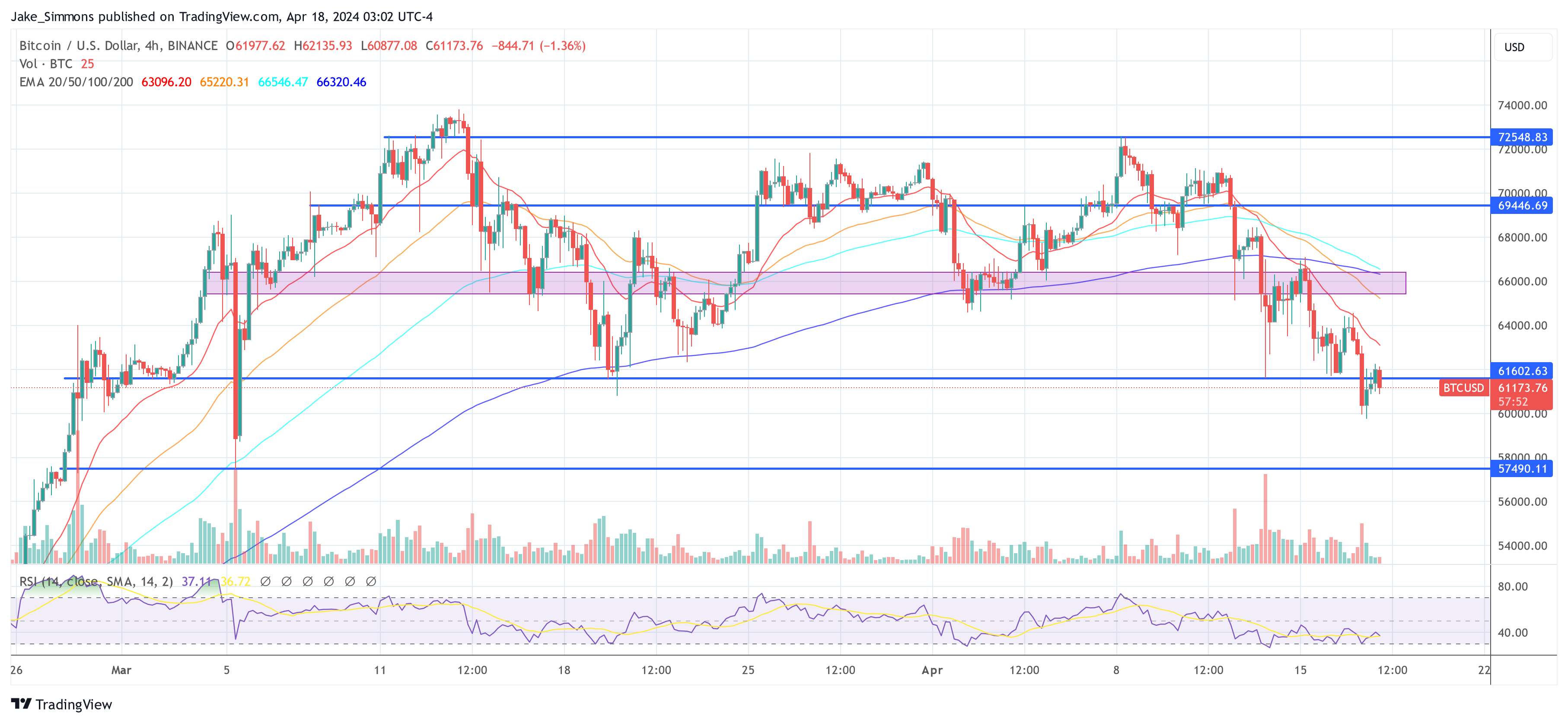
A crypto analyst on X is confident that Bitcoin has bottomed and is poised for major gains in the sessions ahead. Interestingly, the bullish outlook hinges on the Bitcoin market cap retesting all-time highs at press time.
So far, the Bitcoin price is around 2021 highs in USD terms but recently broke all-time highs, peaking at around $73,800. This fluctuation is also reflected in its market cap. It currently stands at $1.25 trillion, down 5% in the past 24 hours.
Notably, it is at the same price level as in 2021, when Bitcoin prices peaked, recording new all-time highs.
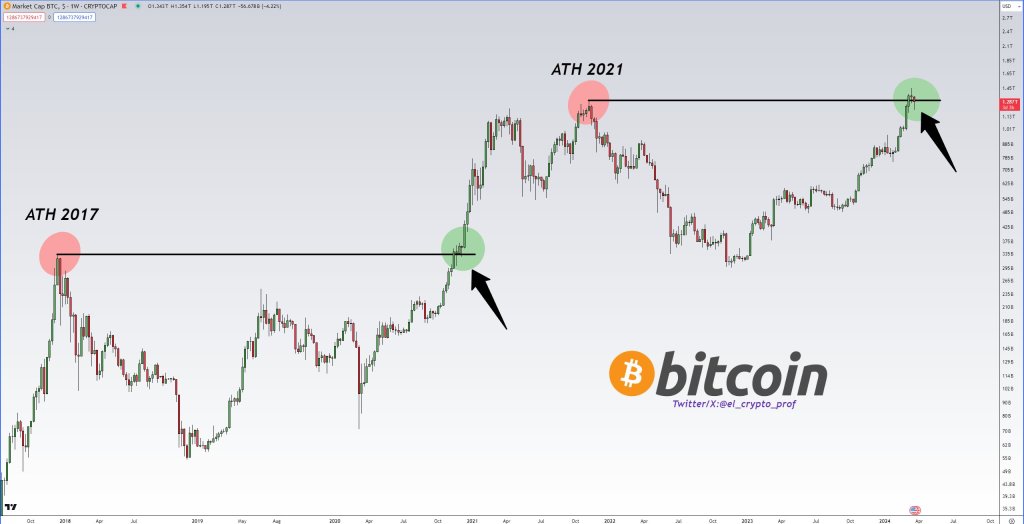
While optimism abounds and the trader expects more sharp price expansions in the days ahead, it is not immediately clear whether the coin will rip higher, aligning with this forecast. Bitcoin is volatile and has remained so despite changing market dynamics.
At the same time, unlike in the past, Bitcoin prices are driven not only by retail forces but by institutions. These institutions are regulated by the United States Securities and Exchange Commission (SEC), which also approved the spot Bitcoin exchange-traded fund (ETF).
This Bitcoin derivative product has been the primary driving force in the past ten weeks. This is from looking at how prices have evolved since its approval in mid-January 2024.
However, since BlackRock and Fidelity are regulated by the United States SEC, unlike retailers, they cannot act as they wish. Considering the millions and billions of dollars at play, their comments or assessments on the coin, now and in the future, can greatly impact sentiment.
Sentiment has been dented when writing. Even with the United States Federal Reserve (Fed) ‘s decision to hold rates at 5.5%, the highest in 2023, lifting prices, there has been no solid follow-through in price action. The coin remains steady below $70,000.
Whether prices will rally over the weekend remains to be seen. However, for now, there are some headwinds to consider.
First, there has been a slowdown in inflows to spot BTC ETFs. At the same time, outflows from the Grayscale Bitcoin Trust (GBTC) have increased. Second, after rallying sharply from October 2023, a cool-off before halving might see the coin trend lower.
In the lead-up to the Federal Open Market Committee (FOMC) meeting scheduled for Wednesday, March 20, the Bitcoin and crypto market is experiencing a severe downtrend. BTC price has plunged roughly -10% in the past two days, and Ethereum (ETH) is down -12% in the same period.
The anticipation surrounding the Fed’s stance on interest rates has heightened in the wake of recent economic indicators, including unexpected spikes in the US Consumer Price Index (CPI) and Producer Price Index (PPI), stirring volatility across markets, including digital assets.
The consensus, with a 99% probability according to the CME FedWatch tool, suggests interest rates will hold steady. Nonetheless, the spotlight turns to the Fed’s dot plot, a graphical representation of the individual members’ expectations for future interest rates, which could provide crucial insights into the monetary policy outlook for the coming months and years.
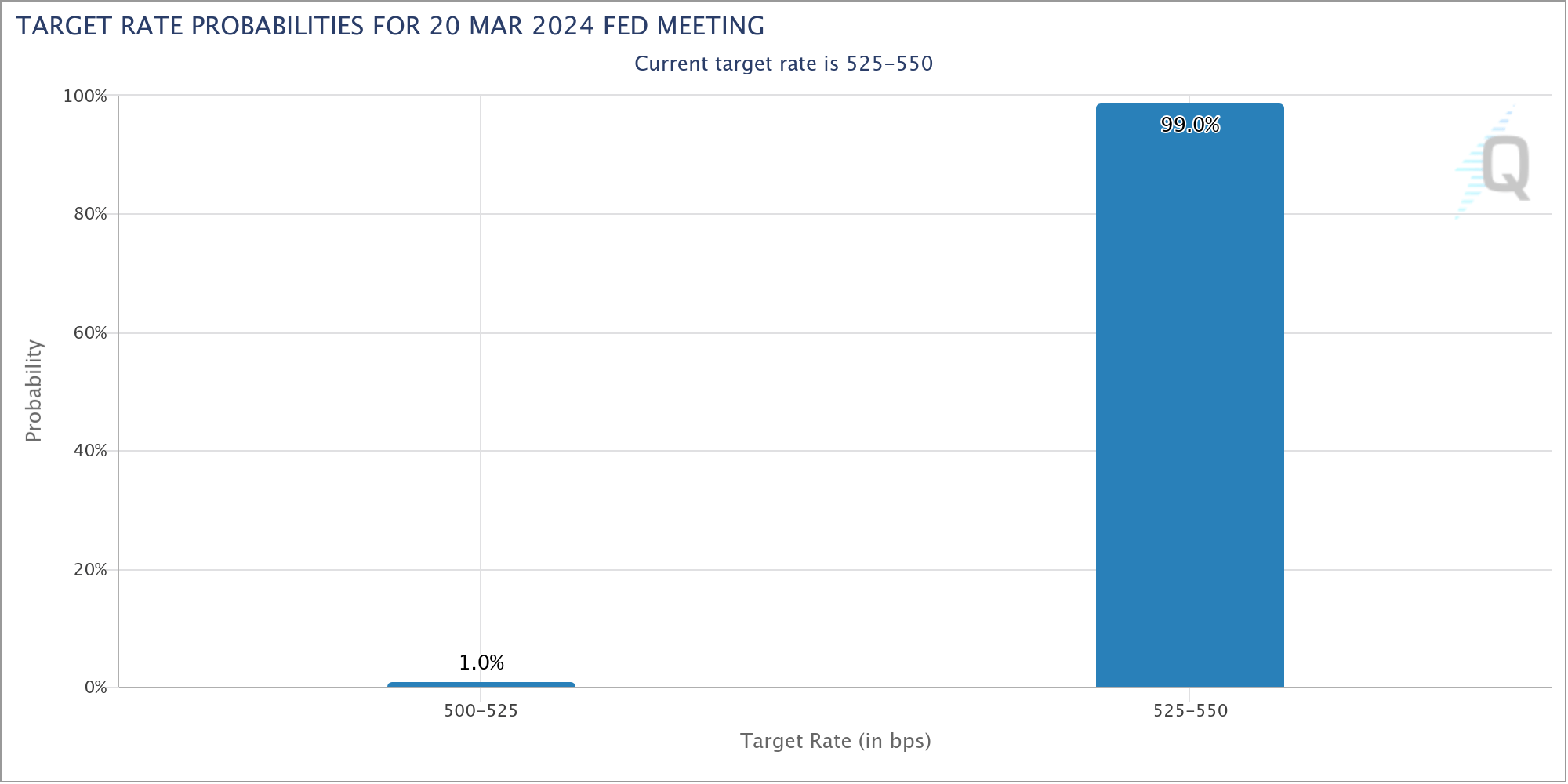
Anna Wong, Chief US Economist for Bloomberg, remarked via X (formerly Twitter), “Another reason why FOMC [is] not ready to cut: members not yet of broad agreement of that need. Here’s visualizing the dispersion of FOMC views with the help of our new weekly NLP Fed spectrometer. “
Another reason why FOMC not ready to cut: members not yet of broad agreement of that need. Here’s visualizing the dispersion of FOMC views with the help of our new weekly NLP Fed spectrometer. (Interactive version at @TheTerminal BECO models —> Fedspeak —> spectrometer) pic.twitter.com/Kney89BERM
— Anna Wong (@AnnaEconomist) March 19, 2024
Macro analyst Ted, expressing his perspective on X, underscores the nuanced relationship between macroeconomic trends and the crypto market at the moment. Ted elucidated that spot Bitcoin ETF flows have taken the backseat while macro factors came to the foreground.
He stated via X, “If BTC is to be considered digital gold, it’s expected to mirror gold’s market movements, albeit with a higher degree of volatility. In the current climate, with the market bracing for the Fed’s upcoming meeting, macroeconomic factors momentarily take precedence, driven by recent developments in PPI and CPI figures.”
He further speculates that “Despite the eventual remarks from [Fed Chair] Powell, the market has already adopted a hawkish stance in anticipation of a ‘higher for longer’ interest rate scenario.”
Michaël van de Poppe, a noted figure in the crypto analysis domain, provided his insights on the recent downward price movement of Bitcoin via X, citing a mix of factors including the anticipation of the FOMC meeting and significant capital outflows from Grayscale‘s Bitcoin Trust. Van de Poppe advises, “It’s typically in these pre-FOMC periods, perceived as risk-off intervals, that the savvy investor finds opportunities to ‘buy the dip’.”
In a reflection of market sentiment adjustments, analyst @10delta on X pointed out the strategic positioning of investors in anticipation of the Fed’s rate decisions. “The market is currently pricing in a reversal to the November ’23 interest rate levels, a clear indication that investors are adjusting their expectations based on the Fed’s potential pivot signaled in the previous dot plot,” he noted.
Accordingly, he argues that the FOMC & dot plot will be a “buy the news” event as the market expectations are being properly adjusted. “The macro worries […] should dissipate & crypto idiosyncratic bullish factors, such as the ETF inflows […] as well as the BTC halving take hold. All considered I think there’s a good R/R for ‘buying the dip’ heading into the March 20 event,” the analyst added.
Goldman Sachs Predicts (Only) 3 Rate Cuts This Year
Goldman Sachs Research recently provided a detailed analysis in their March FOMC Preview. The report highlights the nuanced balance the Fed seeks to achieve between controlling inflation and supporting economic growth.
“Our revised forecast now anticipates three rate cuts in 2024, a slight adjustment from our previous prediction, primarily due to a modest uptick in the inflation trajectory,” Goldman Sachs analysts elucidated. They further speculate, “While the immediate focus is on maintaining current rate levels, the trajectory for rate cuts will hinge on inflation dynamics and economic performance indicators.”
Goldman Sachs further predicts that the Fed will still target a first cut in June. “This combined with a default pace of one cut per quarter implies that the most natural outcome for the median dot is to remain unchanged at 3 cuts or 4.625% for 2024,” the banking giant remarked.
Goldman: Inflation has been firmer in recent months, but we think it is still on track to fall enough by the June FOMC meeting for a first cut. pic.twitter.com/0I1BPYiU8W
— Mike Zaccardi, CFA, CMT
(@MikeZaccardi) March 17, 2024
As the crypto market and broader financial ecosystems await the outcomes of the FOMC meeting, the prevailing sentiment is one of cautious anticipation. Market participants are closely monitoring the Fed’s commentary for indications of future monetary policy directions via the dot plot.
The question for the Bitcoin and crypto market is whether there will be an unpleasant surprise or whether market participants were right with their “higher for longer” policy assumption.
At press time, BTC found support at the $62,400 price level, trading at $63,118.
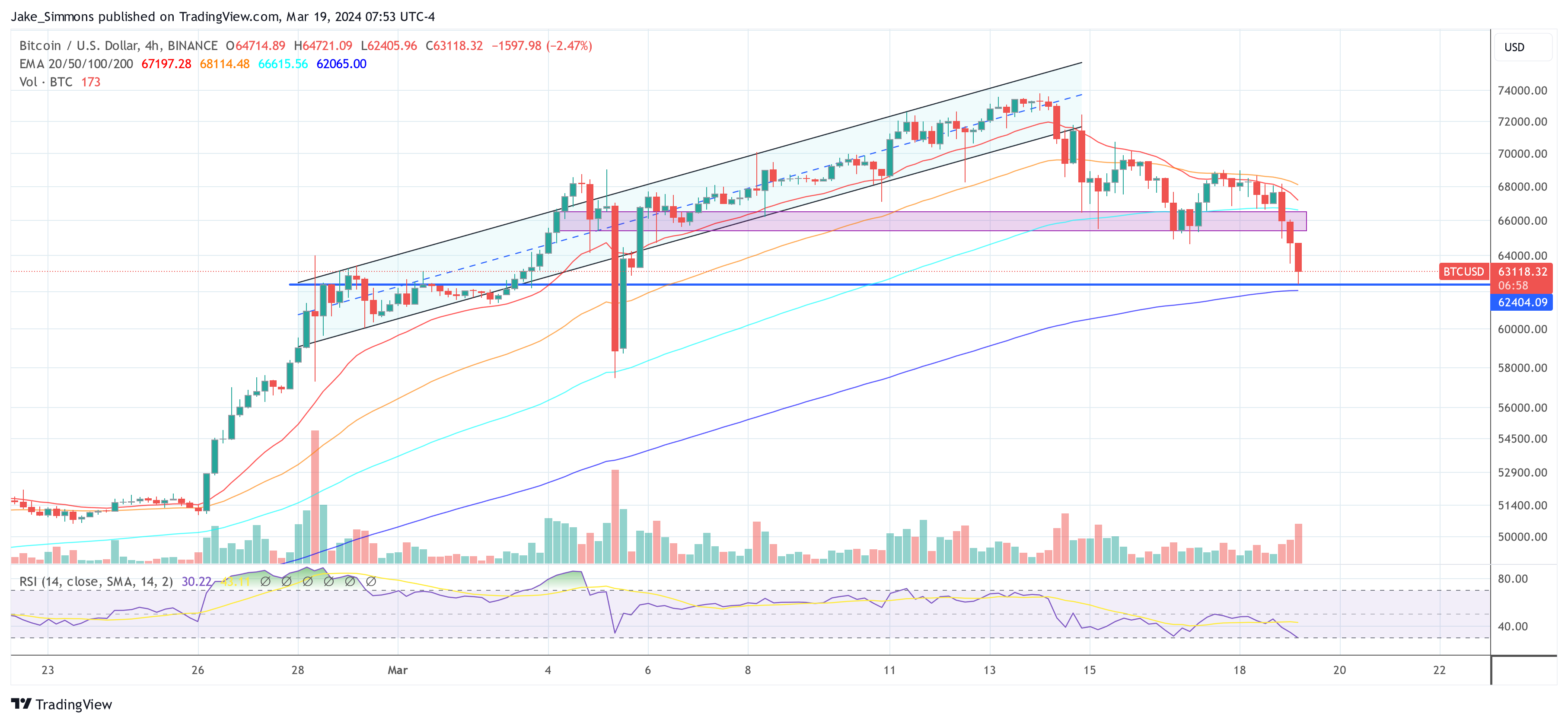
As the US Federal Reserve’s Bank Term Funding Program (BTFP) approaches its conclusion on March 11, 2024, the Bitcoin and crypto market stands at a critical juncture. Instituted in March 2023 in the aftermath of the sudden collapses of Signature Bank and Silicon Valley Bank, the largest since the 2008 financial crisis, the BTFP has been a lifeline for US banks, offering loans against high-quality collateral to ensure liquidity in turbulent times.
The BTFP’s conclusion could send ripples through the financial sector, affecting banks’ liquidity and possibly leading to tighter lending practices. Crypto analyst Furkan Yildirim recently detailed on X, “With the BTFP’s end, banks may face liquidity constraints impacting their operations and profit margins. This could slow down economic growth due to reduced lending.”
However, he added that “the Fed might counter this by adopting a more lenient monetary policy, which could stabilize asset prices and prove beneficial for Bitcoin and the broader market.”
Arthur Hayes, the visionary behind BitMEX, provided a similar opinion in one of his latest essays. He identifies a trio of macroeconomic indicators – the Reverse Repo Program (RRP), the BTFP, and the imminent March interest-rate decision – as pivotal to the Bitcoin and crypto market.
Hayes predicts a severe market correction should liquidity sources, including the BTFP, dry up. “The market could face a harsh reality check without new dollar liquidity injections,” he suggests, indicating a possibly rough transition period for all asset classes, including cryptocurrencies.
The BitMEX founder anticipates a tumultuous March, with the possibility of a 30-40% correction in Bitcoin prices triggered by the BTFP’s expiry. Yet, he remains optimistic about a potential rebound ahead of the Federal Reserve’s meeting on March 20, hypothesizing that anticipatory actions by the Fed, such as rate cuts, could reinvigorate the market.
“This critical period could define the near-term liquidity scenario, offering a rebound opportunity for Bitcoin before further assessing the impact of the Fed’s decisions on market dynamics,” he explains.
Balaji Srinivasan, former CTO of Coinbase, recently also offered a strategic viewpoint on the synchronicity of more key events, “BTFP expires in March. BTC halves in April. RRP runs out in May. All around the same time. So, the US banking system gets stressed right as Bitcoin gets scarce.” His analysis underscores the coincidental timing of the BTFP’s conclusion with Bitcoin’s halving event, suggesting a unique set of circumstances that could amplify market reactions.
Ansel Lindner, host of BTC Markets, provided a commentary amidst growing concerns over regional banking stability. Following revelations of “material weakness” in New York Community Bank’s (NYCB) loan risk tracking and a significant increase in its loan loss reserves earlier this month, Lindner pointed to potential early signs of another banking sector stress.
“It’s starting… Remember what happened to Bitcoin during last March’s banking crisis? The BTFP was created on 12 March 2023, Bitcoin rallied 40% within 2 weeks. #SafeHaven,” Lindner said, highlighting the potential for Bitcoin if the US Fed decides to intertwine again.
In conclusion, the Bitcoin and crypto markets are at a crossroads on March 11, with potential outcomes ranging from significant downturns to bullish recoveries, contingent on the Federal Reserve’s actions and broader macroeconomic trends. The end of the BTFP signifies more than just the cessation of a temporary liquidity program; it represents a moment of truth for the banking sector’s resilience and the crypto market’s response to shifting economic tides.
At press time, BTC traded at $67,005.
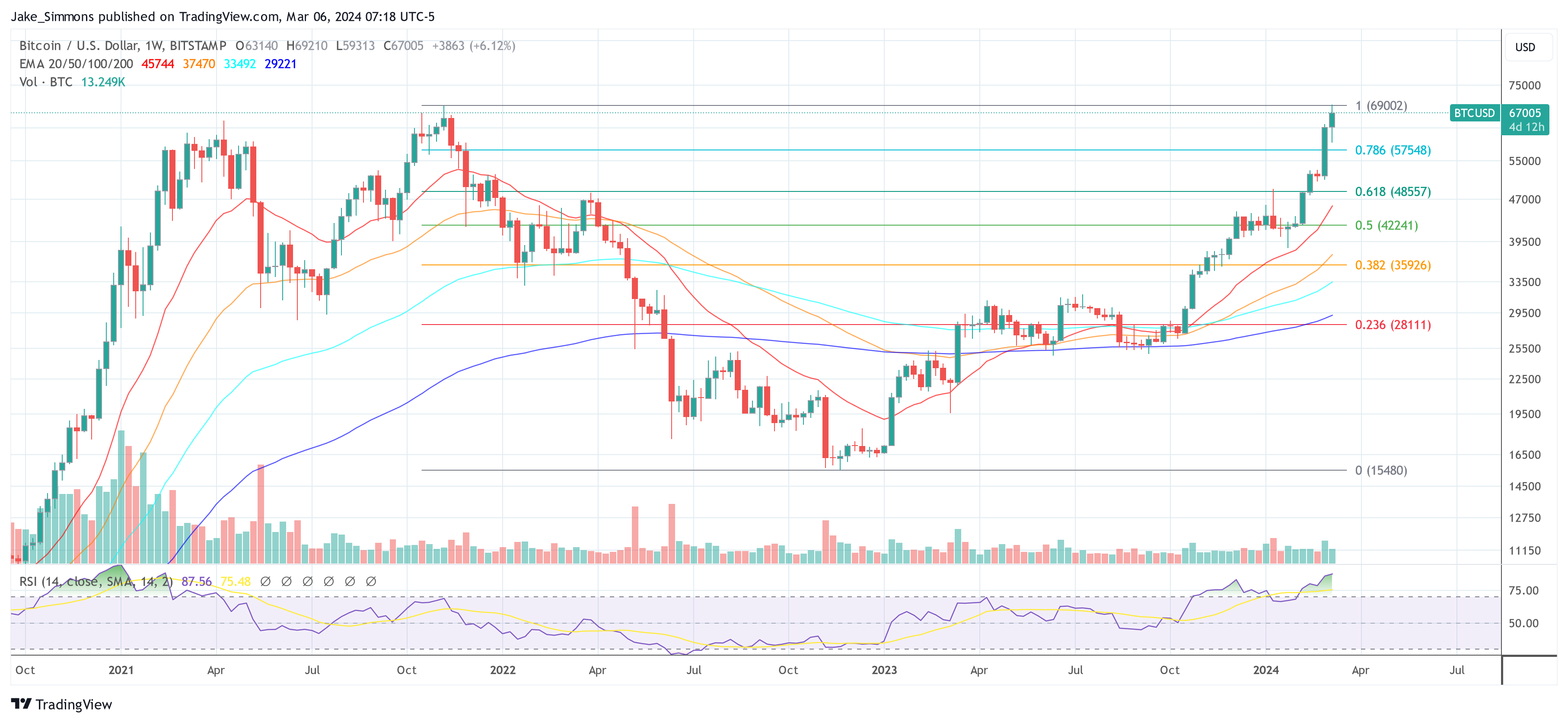
Mike Alfred, a Bitcoin investor and crypto commentator, thinks the “big money algos” are back and predicts the world’s most valuable cryptocurrency will rally to record fresh February 2024 highs but retest all-time highs. This uptick, Alfred says, is before the network finally halves its miner rewards.
Taking to X on February 20, the investor notes that “big money algos just flipped on” and that the uptrend remains. By the time Alfred posted on X, BTC was headed towards the $53,000 before slipping back slightly to around the $59,000 level.
However, the uptrend remains when looking at the candlestick arrangement in the daily chart. Bitcoin has been increasing, defying gravity for the better part of February. At spot rates, analysts, including Alfred, expect the coin to push higher, breaking above $53,000, a stubborn resistance level. If this happens, and considering the sharp breakout, it is likely that buyers will push prices higher towards $60,000 and potentially towards $70,000, as the investor predicts.
Even so, it remains to be seen whether the uptrend will be sustained. When writing, the breakout has been met with solid rejection. Notably, there appear to be “sell walls,” which are large sell orders parked at around $53,000. Still, optimistic bulls expect a triumph, marked by a comprehensive close above this psychological round number.
The crypto community, including the investors, is bullish on Bitcoin. So far, anticipation has been building up for even more gains ahead of halving. Bitcoin halving, an event set at the protocol level, will half miner rewards, possibly inducing a supply shock, assuming the current demand increases.
Presently, Bitcoin supporters believe the network will continue to find more adoption as a medium of exchange and a store of value. With the coin becoming deflationary after halving, the consensus is that prices, guided by historical performance, will rise.
While optimism reigns, Bitcoin remains volatile despite recent institutional participation. Through the spot Bitcoin exchange-traded funds (ETFs), Wall Street players have found a regulated product to channel billions into Bitcoin, reading from the amount of coins scooped in the recent past.
Still, whether the uptrend will continue depends on other macro factors, including monetary policy status in the United States. In March, the United States Federal Reserve (Fed) will guide the interest rate regime. It is a decision that may lift BTC to new levels as a store-of-value asset or force prices lower as capital rotates that to the greenback.
Feature image from Shutterstock, chart from TradingView
The state of Bitcoin (BTC) price action across multiple time frames has analysts at the edge of their seats. As of February 7, various technical formations suggest that the leading crypto appears poised for a critical breakout from the current consolidation.
Taking to X, Mags thinks Bitcoin is in for a “big move,” considering the candlestick arrangement in the weekly chart. The analyst notes that prices have been moving horizontally in the past nine weeks, falling within the expected range.
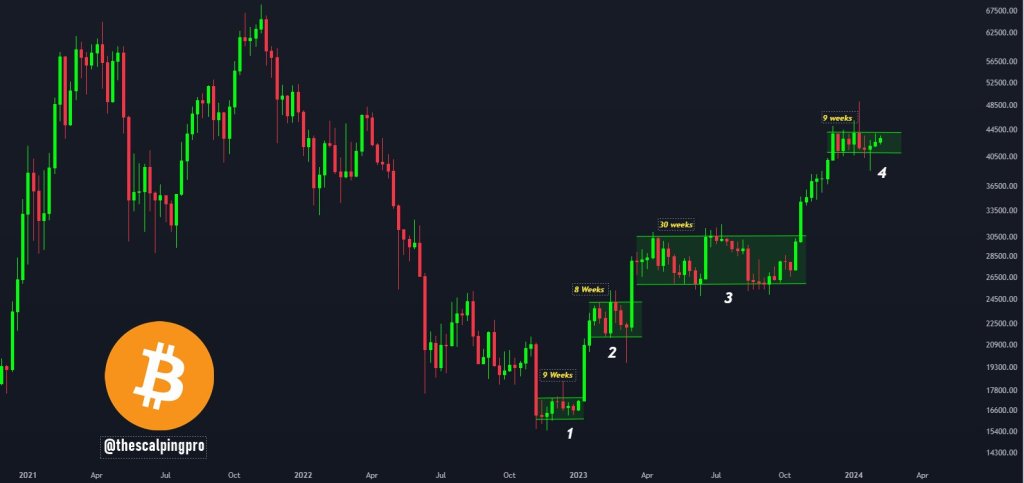
The Bitcoin market has ranged between 8 and 30 weeks in the past. So far, the current consolidation has lasted for nine weeks. Amid this, Bitcoin prices have tested both sides of the range with notable “fake-outs.”
In light of the current state of affairs in the Bitcoin market, Mags is confident that the prolonged consolidation suggests that the coin, guided by history, could edge higher.
Beyond the ranging market, another analyst notes that the Bitcoin 3-day Bollinger Bands, a technical indicator that measures volatility, is narrowing. The squeeze, the trader notes, is at historical levels, often followed by a breakout. However, as it is, how prices will evolve in the weeks and months ahead remains uncertain.
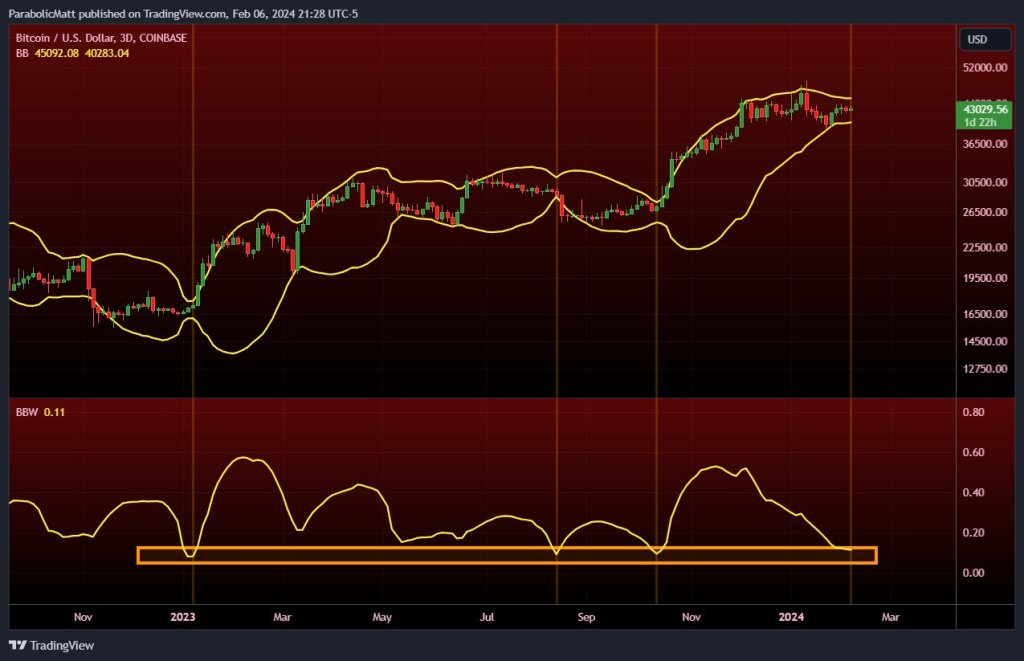
Adding to the intrigue, Jason Goepfert on X points out that the S&P 500, a stock market index, is currently within 0.35% of its 3-year high. The uptrend is clear even though less than half of all stocks constituting the index are trading above their 10-day moving average.
At the same time, less than 60% are above their 50-day moving average, and fewer than 70% are above their 200-day moving average. This rare confluence suggests that the financial market could be at a critical turning point, possibly impacting crypto.
Only time will tell whether Bitcoin will rally or tank from spot rates. However, what’s evident is that the Bitcoin uptrend remains clear, with fundamentals aligning to support optimistic bulls. To illustrate, spot Bitcoin ETF issuers are buying more coins from the market. At the same time, the excitement around the upcoming Bitcoin halving event is adding fuel to the optimism.
The broader market is also watching the United States Federal Reserve. Market consensus is that the central bank will slash interest rates in March 2024 and embark on quantitative easing. With more money circulating, some will find their way to Bitcoin, driving prices to record highs of $69,000 or beyond in the coming months.
Analysts at cryptocurrency exchange Coinbase are backing Bitcoin and the entire crypto market to put up a significantly positive performance in Q2 2024. This development comes as BTC continues its market recovery, gaining by 3.31% in the last week to trade above $43,000.
In the Coinbase weekly report on Friday, the American exchange’s analysts noted that the market factors that induced downward pressure on Bitcoin were being phased out. This claim is backed by the completion of the GBTC’s liquidations by defunct exchange FTX as well as the recovery of certain crypto entities from bankruptcy, indicating a change in the dynamics of the BTC market.
Furthermore, the analysts also highlighted the stable performance of the Bitcoin spot ETF market in the last week, marked by average daily net inflows of $200 million and a daily trading volume of $1.35 billion in the last week. However, in the coming weeks, Coinbase market experts have predicted the macroeconomic factors to gain more influence in the crypto market.
In particular, the analysts made reference to the US Federal Reserve’s decision to postpone the deliberation on scaling back its quantitative tightening (QT) to the next Federal Open Market Committee (FOMC) meeting in March. Based on this development, they predict the easing cycle will begin on May 1, which typically involves measures such as lowering interest rates to make loans cheaper and stimulate economic activity. In addition, they anticipate the Fed to start halting its balance sheet reductions by June to further support the US economy.
Interestingly, they believe the Fed could consider implementing the end of the balance sheet reduction at the same time with rate cuts. Based on the “anodyne” policies policymakers implement in an election year, Coinbase analysts predict the US apex bank will cut interest rates by 100 basis points (bps) – 25bps more than the Fed’s expectation for future rates – which is equivalent to lowering rates by 1%.
Generally, a reduction in interest rates is a positive omen for the digital asset ecosystem as it allows investors to pay low borrowing fees, accumulating more funds to invest in risk assets such as crypto tokens. Based on the multiple factors listed above combined with “idiosyncratic” factors, such as the Bitcoin halving, the analysts at Coinbae predict BTC, alongside other tokens, will serve as favorable portfolio additions in Q2 2024.
At the time of writing, Bitcoin trades at $43,077.76 with a 0.20% gain in the last day. Meanwhile, the asset’s daily trading volume is down by 15.45% and is valued at $16.78 billion. With a market cap of $844.85 billion, BTC continues to rank as the largest cryptocurrency in the world.
Arthur Hayes, the founder of BitMEX, has offered an in-depth analysis of the current financial landscape and its potential impact on Bitcoin, especially in light of the recent challenges faced by New York Community Bancorp (NYCB) and the broader banking sector.
Hayes’s analysis draws on the complex interplay between macroeconomic policies, banking sector health, and the cryptocurrency market. His comments are particularly insightful given the recent developments with NYCB. The bank’s stock plummeted by 46% due to an unexpected loss and a substantial dividend cut, which was primarily attributed to a tenfold increase in loan loss reserves, far exceeding estimates.
This incident raised red flags about the stability and exposure of US regional banks, particularly in the real estate sector, which is known to be cyclically sensitive and vulnerable to economic downturns. The stock market reacted negatively to these developments, with regional US bank stocks also declining due to NYCB’s performance.
Hayes explicitly stated, “Jaypow [Jerome Powell] and Bad Burl Yellen [Janet Yellen] will be printing money very soon. NYCB annc a ‘surprise’ loss driven by loan loss reserves rising 10x vs. estimates. Guess the banks ain’t fixed.” This comment underscores the persisting fragility of the banking sector, still reeling from the shocks of the 2023 banking crisis. He added, “10-yr and 2-yr yields plunged, signaling the market expects some sort of renewed bankster bailout to fix the rot.”
Furthermore, Hayes highlighted the impending conclusion of the Federal Reserve’s Bank Term Funding Program (BTFP), which was introduced in response to the 2023 banking crisis. The BTFP was a critical instrument in providing liquidity to banks, allowing them to use a wider range of collateral for borrowing.
Hayes anticipates market turbulence leading to the Fed possibly reinstating the BTFP or introducing similar measures. In a recent statement, he noted, “If my forecast is correct, the market will bankrupt a few banks within that period, forcing the Fed into cutting rates and announcing the resumption of the BTFP.” This scenario, he argues, would create a liquidity injection that could buoy cryptocurrencies like Bitcoin.
In his latest post on X, Hayes drew parallels to the cryptocurrency’s performance during the March 2023 banking crisis. He predicts a similar trajectory, suggesting a brief dip followed by a significant rally:
Expect BTC to swoon a bit, but if NYCB and a few others dump into the weekend, expect a new bailout right quick. Then BTC off to the races just like March ’23 price action. […] I think it might be time to get back on the train fam. Maybe after a few US banks bite the dust this weekend.
During the March crisis, Bitcoin’s value jumped over 40%, a reaction attributed to its perceived role as a digital gold or a safe-haven asset amid financial instability. On a longer time horizon and with the Great Financial Crisis from 2008 in mind, he further argued, “What did the Fed and Treasury do last time US property prices plunged and bankrupted banks globally? Money Printer Go Brrrr. BTC = $1 million. Yachtzee.”
At press time, BTC traded at $42,232.
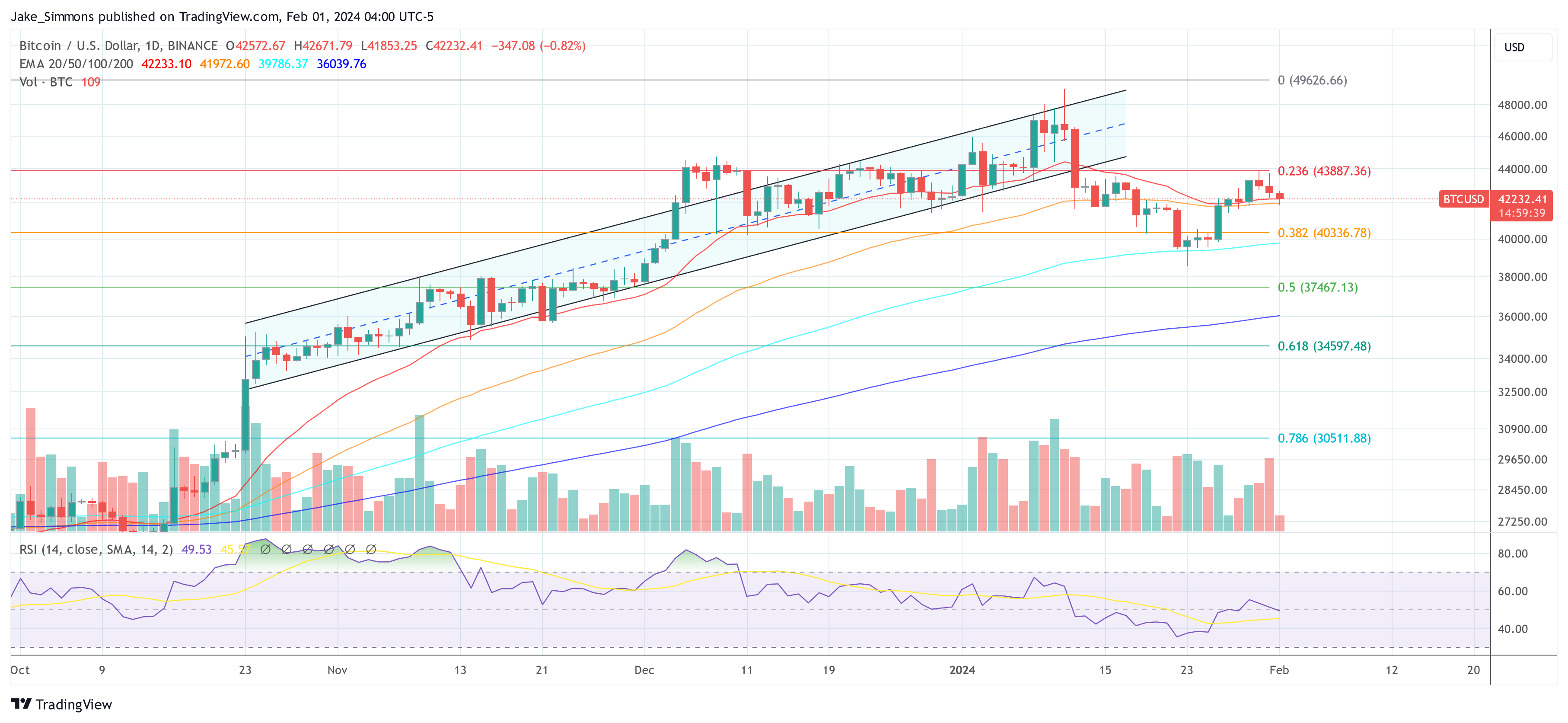
After a challenging two weeks resulting in a 21% drop, the Bitcoin (BTC) price rebounded emphatically, closing last week on a strong note. The premier cryptocurrency witnessed a surge that saw it end with a Doji Hammer candle on its weekly chart, signaling a potential bullish reversal. Notably, this uptick has propelled Bitcoin’s value back into its previous range of $41,300 to $45,000.
Keith Alan, the co-founder of Material Indicators, highlighted the significance of this pattern, stating, “Looks like we have a Doji Hammer candle forming on the BTC Weekly chart. That typically indicates a bullish reversal is coming. […] If we do indeed print a Hammer, Bitcoin bulls will need to overcome resistance at the bottom range of the Golden Pocket to have a chance at a meaningful move to retest the $44k – $45k range.”
Bitcoin has also reclaimed its position above the 20- and 50-day Exponential Moving Averages (EMAs), hinting at the potential for further gains. However, the anticipation surrounding the first Federal Open Market Committee (FOMC) meeting of 2024 adds a layer of complexity to Bitcoin’s trajectory.
The upcoming Federal Open Market Committee (FOMC) meeting, is anticipated to be a major determinant in the short-term movement of Bitcoin’s price, as it could signal significant shifts in the United States Federal Reserve’s monetary policy approach.
Macro analyst @tedtalksmacro provided an in-depth perspective: “This week’s FOMC meeting is pivotal.” Currently, the market is expecting the Fed to maintain the status quo, with a 97% probability against any policy change.
“However, there’s a 46% chance of a rate cut by the March meeting. Investors should closely monitor for signs of the Fed moving towards a data-dependent approach, any recognition of inflation nearing their 2% target, and potential adjustments to Quantitative Tightening (QT) policies,” Ted remarked.
After this week, the Committee will meet again on March 19-20. Thus, this week’s FOMC meeting could lay the foundation for the critical decisions in March, which could have immediate and pronounced effects on market dynamics.
The Federal Reserve has forecasted that it will reduce interest rates three times this year. The market anticipates a possibility of five or more cuts. There is a general agreement that the initial reduction in rates might occur in the second quarter, though there is substantial support for the possibility of it happening at the March meeting.
Goldman Sachs has been consistently predicting a rate cut by the Fed in March. Their analysis is grounded in the significant progress observed in inflation control.
The post-FOMC meeting press conference will be a focal point, as investors seek clarity on the collective view of the FOMC members, including the newly rotated regional Fed bank presidents. These officials, known for their cautious approach towards rate cuts, will play a significant role in shaping the committee’s decision-making process.
December’s inflation report indicated a 3.4% year-on-year increase, with core prices rising more rapidly than many economists had projected. However, the Department of Commerce’s personal consumption expenditures (PCE) index, the Fed’s preferred inflation measure, showed more promising signs of inflation cooling down to 2.9%, aligning closer to the Fed’s target.
Renowned crypto analyst @ColdBloodShill drew attention to the historical inverse correlation between the DXY (Dollar Index) and Bitcoin. He shared the following chart and stated: “Heard you needed some hopium. The last two FOMC events have marked the pico top of the DXY. Next one on Wednesday.”
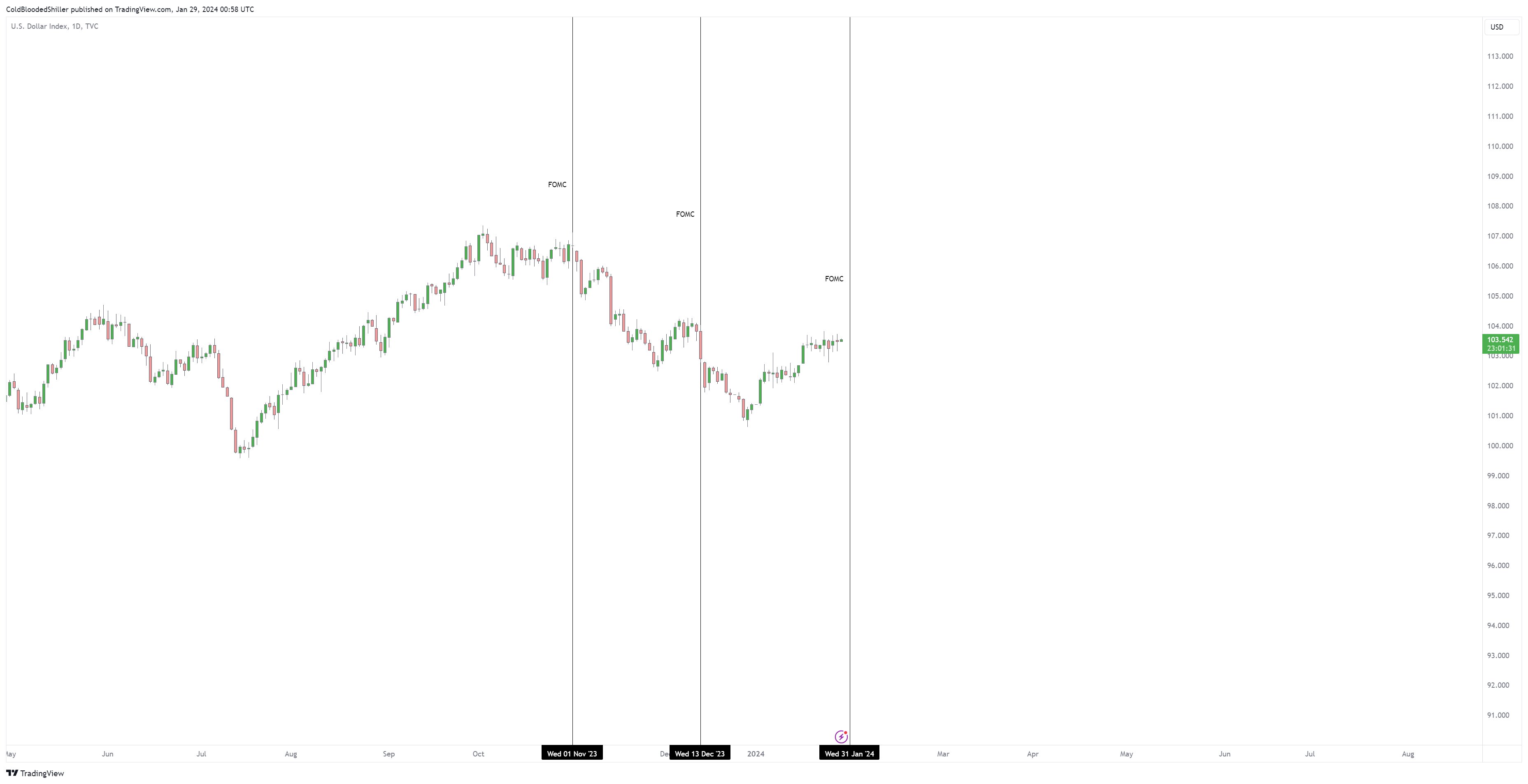
A potential drop in the DXY following the FOMC meeting could act as a catalyst for Bitcoin to rise towards the $45,000 mark. In addition, there are possible changes in QT policy that could indicate an increase in the supply of money. Such developments could serve as a major catalyst for the Bitcoin price as the hardest asset of the world.
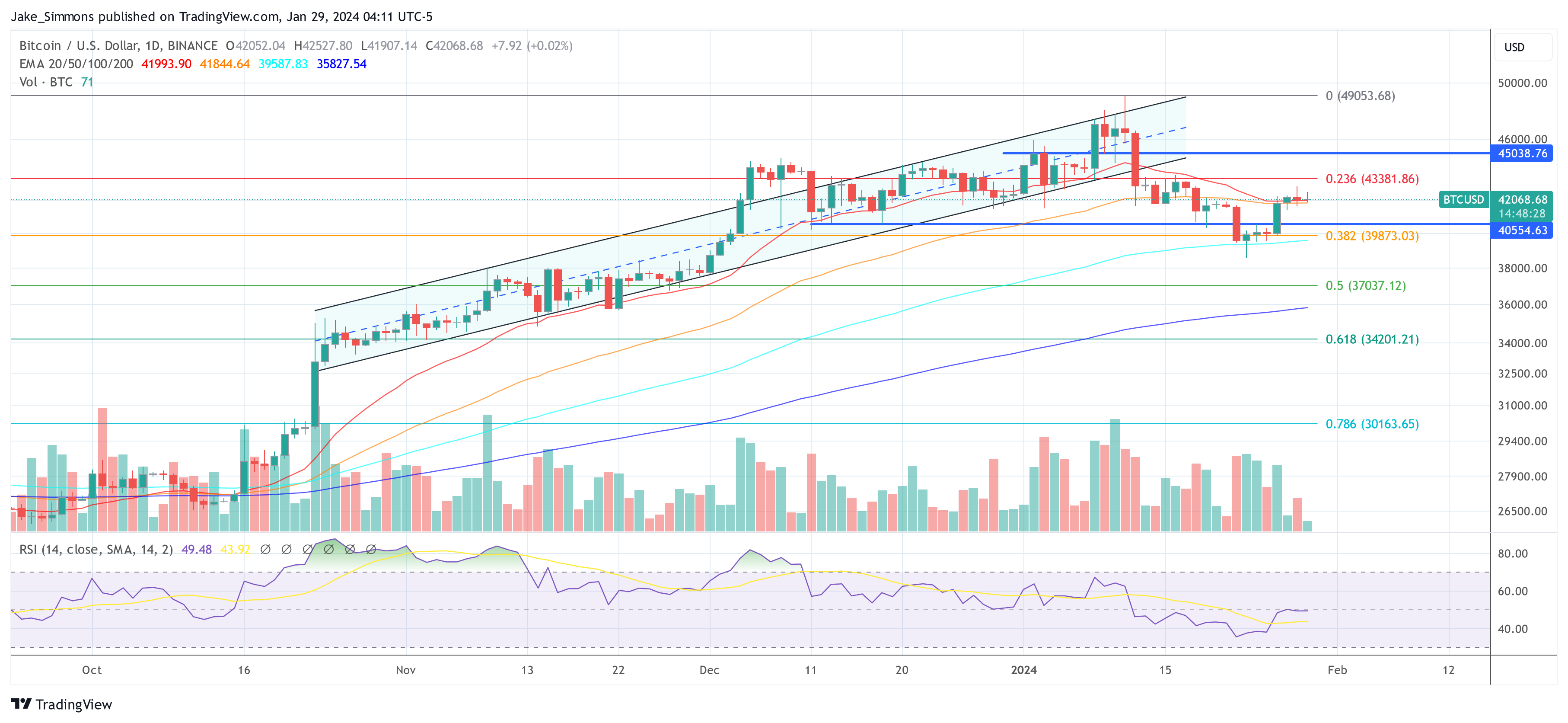
In his latest essay, Arthur Hayes, the founder of BitMEX, articulates a contrarian perspective on the recent downturn in Bitcoin’s price, refuting the mainstream narrative that attributes the decline to outflows from the Grayscale Bitcoin Trust (GBTC). Instead, Hayes points to macroeconomic maneuvers and monetary policy shifts as the real drivers behind Bitcoin’s volatility.
Hayes kickstarts his analysis by shedding light on the US Treasury’s recent strategic shift in borrowing, a decision announced by Janet Yellen on November 1. This pivot towards Treasury bills (T-bills) has triggered a substantial liquidity injection, compelling money market funds to reallocate their investments from the Fed’s Reverse Repo Program (RRP) to these T-bills, offering higher yields.
Hayes articulates the significance of this move, stating, “Yellen acted by shifting her department’s borrowing to T-bills, thus adding hundreds of billions of dollars’ worth of liquidity so far.” However, he contrasts this tangible financial maneuver with the Federal Reserve’s mere rhetoric about future rate cuts and the tapering of quantitative tightening (QT), pointing out that these discussions have not translated into actual monetary stimulus.
While the traditional financial markets, particularly the S&P 500 and the Nasdaq 100, responded positively to these developments, Hayes argues that Bitcoin’s recent price trajectory serves as a more accurate barometer of the underlying economic currents. He remarks, “The real smoke alarm for the direction of dollar liquidity, Bitcoin, is throwing a cautionary sign.”
He notes the cryptocurrency’s decline from its peak and correlates it with the fluctuations in the yield of the 2-year US Treasury, suggesting a deeper economic interplay at work. “Coinciding with Bitcoin’s local high, the 2-year US Treasury yield hit a local low of 4.14% in mid-January and is now marching upwards,” Hayes remarked.
Addressing the narrative surrounding GBTC, Hayes emphatically dismisses the notion that outflows from GBTC are the primary catalyst for Bitcoin’s price movements. He clarifies, “The argument for Bitcoin’s recent dump is the outflows from the Grayscale Bitcoin Trust (GBTC). That argument is bogus because when you net the outflows from GBTC against the inflows into the newly listed spot Bitcoin ETFs, the result is, as of January 22nd, a net inflow of $820 million.”
This realization shifts the focus to economic mechanisms at play. The crux of Hayes’s argument lies in the anticipation surrounding the Bank Term Funding Program (BTFP)‘s expiration and the Federal Reserve’s hesitancy to adjust interest rates to a range that would alleviate the financial strain on smaller, non-Too-Big-to-Fail (TBTF) banks.
Hayes elucidates, “Until rates are reduced to the aforementioned levels, there is no way these banks can survive without the government support provided via the BTFP.” He predicts a looming mini-financial crisis in the event of the BTFP’s cessation, which he believes will compel the Federal Reserve to pivot from rhetoric to tangible action—namely, rate cuts, a tapering of QT, and potentially a resumption of quantitative easing (QE).
“I believe Bitcoin will dip before the BTFP renewal decision on March 12th. I didn’t expect it to happen so soon, but I think Bitcoin will find a local bottom between $30,000 and $35,000. As the SPX and NDX dump due to a mini financial crisis in March, Bitcoin will rise as it will front-run the eventual conversion of rate cuts and money printing talk on behalf of the Fed into the action of pressing that Brrrr button,” Hayes writes.
In a revealing glimpse into his tactical trading strategies, Hayes shares his approach to navigating the tumultuous market landscape. He discloses his positions, including the purchase of puts and the strategic adjustment of his BTC holdings. He concludes:
A 30% correction from the ETF approval high of $48,000 is $33,600. Therefore, I believe Bitcoin forms support between $30,0000 to $35,000. That is why I purchased 29 March 2024 $35,000 strike puts. […] Bitcoin and crypto in general are the last freely traded markets globally. As such, they will anticipate changes in dollar liquidity before the manipulated TradFi fiat stock and bond markets. Bitcoin is telling us to look for Yellen and not Talkin’.
At press time, BTC traded at $39,963.
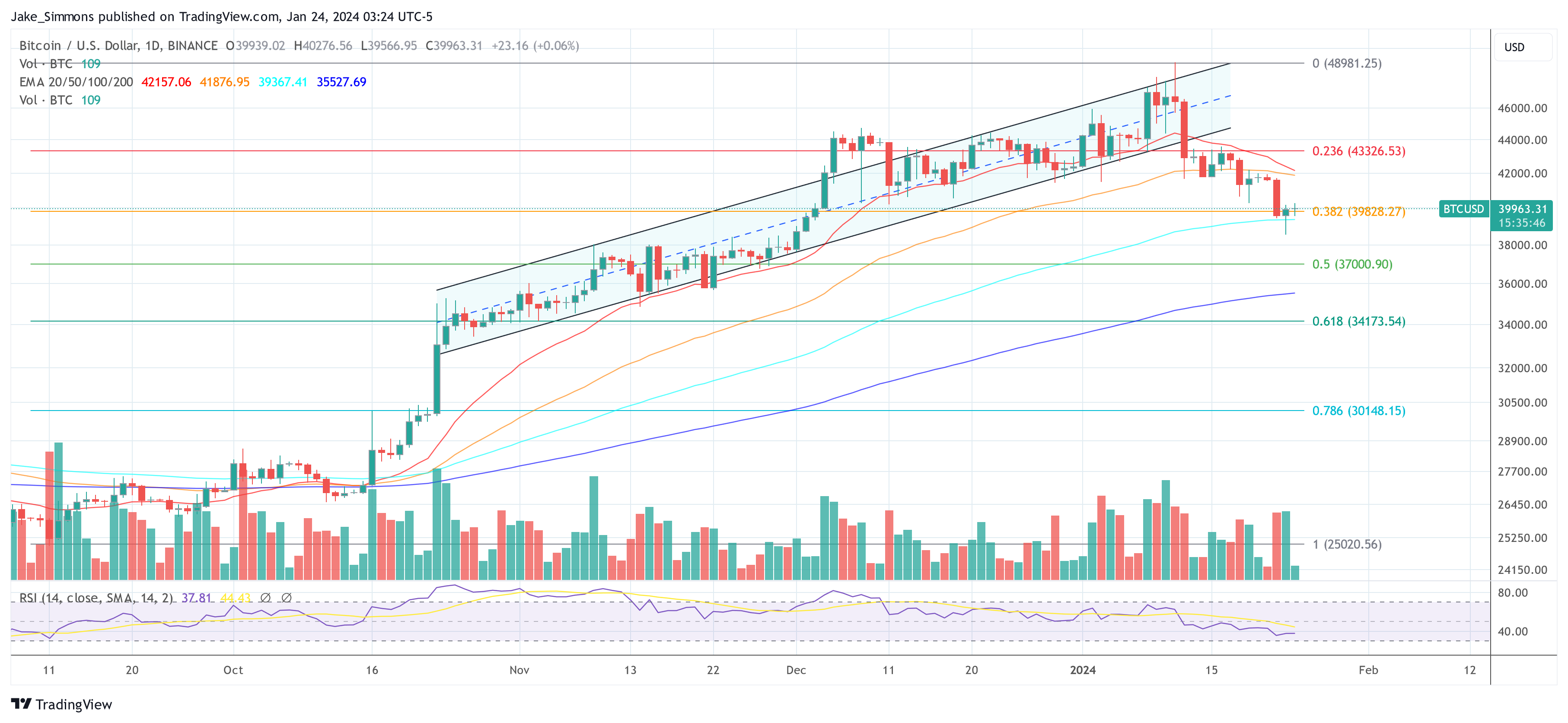
Renowned analyst Ted (@tedtalksmacro) has offered a detailed forecast for 2024 in the crypto market. His analysis on X (formerly Twitter) touches on several critical points, from macro events, the Bitcoin Halving to fresh liquidity in the market.
This is going to be quite a long post, summing up 2023 and looking ahead to the themes to watch if you're investing in 2024 – so please bare with me
Summing up 2023
– China printed almost $1 trillion dollars but failed to push their economy out of the dumps– US…
— ted (@tedtalksmacro) January 11, 2024
Following the approval of spot Bitcoin ETFs and the anticipated approval of spot Ethereum ETFs, there is an expectation for a broader range of altcoin ETFs to emerge. Ted believes that the success of these initial ETFs will pave the way for more proposals and approvals, potentially by 2025.
He states, “The SEC has laid the precedent for many other crypto products to be proposed and approved, opening up even more avenues for large capital inflows into the crypto asset class.” Ted specifically mentions Solana and XRP as likely candidates for future ETFs. This development is seen as a significant step in attracting substantial capital inflows into the crypto asset class.
Ted forecasts that the Federal Reserve might cease or significantly slow down its current quantitative tightening (QT) program by Q3 of 2024. This prediction is based on the declining cash balance in reverse repos and aims to avoid a repeat of the funding stress experienced in 2019.
“An end to or a dramatic slowdown of the current QT programme could come even earlier though, given the scars of what happened back in 2019 following the monetary tightening of 2018,” he predicts. An end to QT could inject more liquidity into the market, potentially benefiting crypto assets.
After a challenging period of 18 months marked by the collapse of crypto funds and exchanges and central bank tightening, Ted anticipates a return of liquidity to the crypto space. He points to stablecoin liquidity deltas approaching positive territory and the role of spot Bitcoin ETFs in attracting new capital, especially from investors seeking higher returns amid inflationary pressures.
The anticipated Bitcoin halving in April 2024 is expected to create both a supply shock (due to reduced mining rewards) and a demand shock (following the approval of spot BTC ETFs). Historically, halvings have catalyzed significant price movements in Bitcoin, and Ted expects a similar pattern in 2024, with potential for substantial price increases following a brief post-halving sell-off.
On the topic of inflation, Ted observes, “It typically takes 12-18 months for the full effects of changes in monetary policy to be felt in the economy, and we are verging into that territory now.” Despite the base effects of the 2021/22 inflation fading, Ted foresees a slight resurgence in inflation as economies continue to operate robustly.
However, he believes the central banks’ commitment to maintaining higher interest rates will cap the inflation rate below previous highs. He views this as an integral aspect of a strong economy and market.
Having witnessed AI go mainstream in 2023, Ted predicts 2024 to be a year of unprecedented improvements in AI technologies. This advancement is expected to boost AI stocks, crypto, and related products, enhancing productivity and potentially leading to deflation in developed economies.
Contrary to predictions of a major recession, Ted anticipates continued economic growth, albeit at a slower pace than in 2023. Ted says, “Those calling for a recession akin to 08 or the Great Depression are likely to be disappointed… again.” He attributes this resilience to governments’ aggressive fiscal policies, including substantial cash injections and running large deficits.
Ted notes that China, struggling in the post-COVID era, is likely to continue its aggressive monetary policy, as evidenced by nearly $1 trillion printed in 2023. He draws parallels with Japan’s situation in the 1990s, highlighting China’s focus on stimulating production over its flailing property market.
In summary, Ted’s analysis for 2024 presents a complex and dynamic picture of the crypto market, influenced by macroeconomic factors, regulatory developments, technological advancements, and geopolitical forces. These trends suggest a year of significant opportunities for investors in the crypto space.
At press time, BTC traded at $47,244, up 5.1% in the last 24 hours.
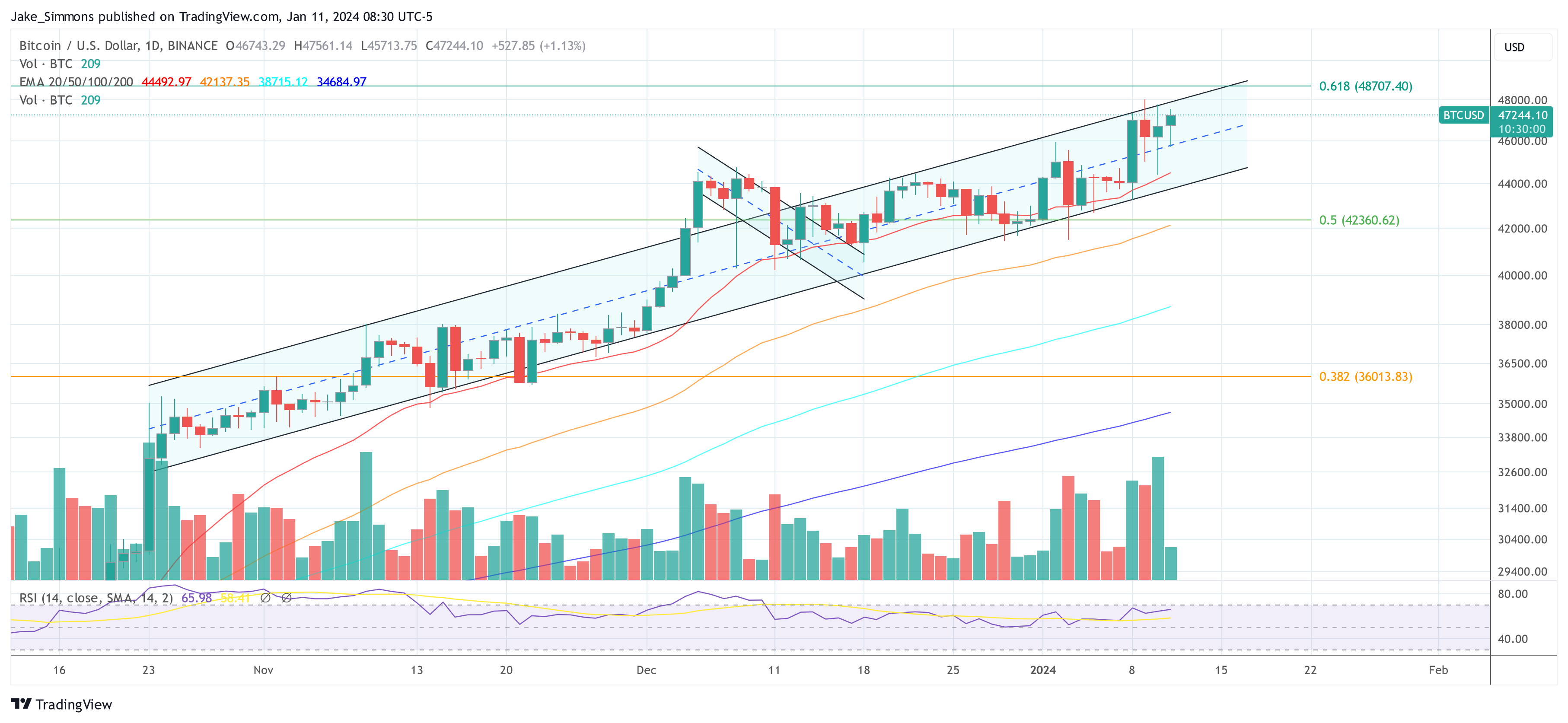

Professional Bitcoin traders were unaffected by the recent 9.6% price correction, and derivatives data reflects a healthy market.

Bitcoin traders eye BTC price levels of interest as U.S. PPI preserves declining inflation narrative ahead of Fed rates decision.

BTC price action obliterates latecomers betting on continued upside as Bitcoin analysts and miners alike breathe a sigh of relief.

Bitcoin funding rates are in classic bull market territory, but can BTC price upside sustain as macro volatility triggers line up?

Tech stocks face trillion-dollar losses as bond yields soar, but their $596 billion cash positions favor alternative hedges, including Bitcoin.

Tech stocks face trillion-dollar losses as bond yields soar, but their $596 billion cash positions favor alternative hedges, including Bitcoin.
In a recent post on X (formerly Twitter), Ram Ahluwalia, the CEO of Lumida Wealth, weighed in on the potential market impacts on Bitcoin, particularly highlighting the significance of a failed Treasury auction. Lumida Wealth, recognized as an SEC registered investment advisor, is known for its specialization in alternative investments and digital assets.
Ahluwalia’s tweet emphasized the need to monitor Bitcoin’s response to specific macroeconomic events. He stated, “The test for Bitcoin as a macro asset will be ‘What happens if there is a failed Treasury auction?’ This year, Bitcoin rallied during (1) the March bank failures and (2) as Treasury rates have rattled markets. Here is the third test …”
To recall, Bitcoin’s price shot up by over 55% in the aftermath of the US banking crisis earlier this year. On March 10, 2023, the Silicon Valley Bank’s unprecedented collapse, attributed to a bank run coupled with a capital crisis, became a focal point of the broader 2023 United States banking crisis. This saw a domino effect with multiple small to mid-sized US banks falling within a span of five days. While the global banking sector stocks plummeted, Bitcoin experienced a substantial surge in its value.
More recently, Bitcoin is rallying even as treasury rates continue to unsettle global markets. With the 10-year US Treasury yield crossing the 5% mark for the first time in 16 years, there are indications of rising interest rates on government bonds. Typically, such yield increments may push investors to reconfigure their portfolios away from risk assets, adding to market volatility. However, akin to gold, Bitcoin has recently been acting as a safe-haven asset in turbulent times.
Diving deeper into the topic, Ahluwalia elucidated, “The Bitcoin rally, in part, is due to concerns that the Federal Reserve may need to intervene with Yield Curve Control or QE. […] Fidelity makes the case that the Fed may need to engage in Japanese style Yield Curve Control. If so, that would be strongly bullish for real estate, stocks, Bitcoin, bonds, REITs, TIPS and real assets more generally. It would also be bearish for the USD. The US has hard choices ahead.” He further emphasized the importance of structuring portfolios to withstand potential economic shocks and underscored the importance of commodities in weathering inflationary pressures.
Ahluwalia shared his perspective on the current state of the Federal Reserve and the Treasury markets, pointing to recent Treasury auctions that displayed softer bid-to-cover ratios. “There is a legitimate argument that the Fed may need to intervene in Treasury markets. The recent Treasury auctions have weaker bid-to-cover ratios. Japan and American households are the marginal buyer…and they’ve been rewarded with losses,” Ahluwalia remarked.
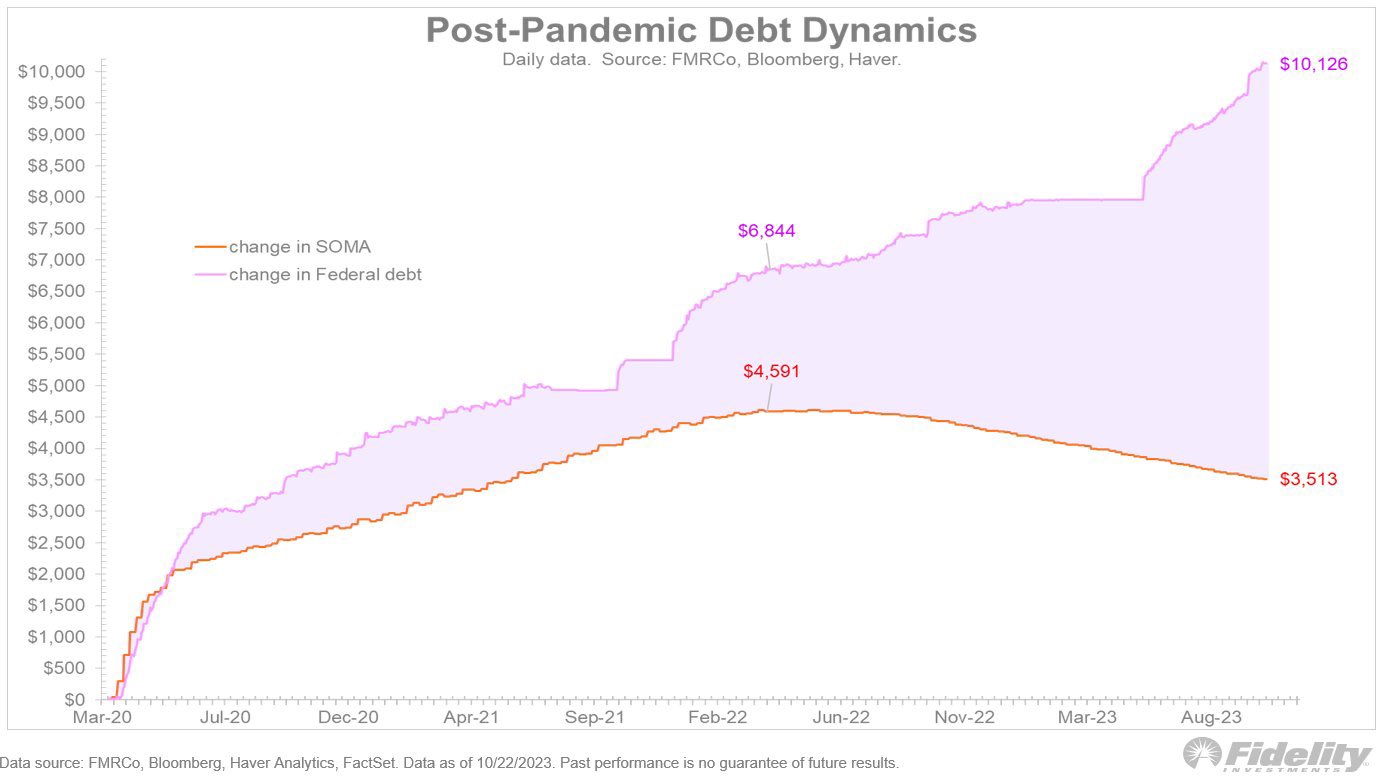
He added that the Fed’s balance sheet “is already upside down […] it has the equivalent of negative equity (called a Deferred Asset) – an accounting treatment that is not permitted for private companies… The Federal Reserve…has $1.5 trillion mark-to-market losses because it bought Treasuries & MBS. For the first time in 107 years, this bank has negative net interest margin. Its losses are poised to exceed its capital base.”
Ahluwalia explained that a treasury auction is deemed unsuccessful when the US Department of the Treasury initiates its regular auctioning of government securities, such as Treasury bills, notes, or bonds, but fails to attract adequate bids to cover the entirety of the securities on offer. Essentially, this signals a lack of investor interest in acquiring the government’s debt tools at the predetermined interest rates or yields.
On Bitcoin’s intrinsic value, Ahluwalia noted, “My view on Bitcoin is that it is a ‘hedge against negative real rates’. That’s CFA talk for what Bitcoiners refer to colloquially as ‘money printer go brrr’.” He also stressed the potential repercussions on risk assets if long-end rates were to see a significant spike.
“If long-end rates do blow out, that would hurt risk assets like long-duration Treasuries. The higher discount rate would cause a re-rating in stocks – much like we saw in 2022 and the last two months. However, If Bitcoin can rally during a ‘yield curve dislocation scenario that would give Bitcoin a ‘three peat’. Bitcoin would then find a welcome home on a greater number of institutional balance sheets,” Ahluwalia concluded his bullish thesis for Bitcoin.
At press time, BTC traded at $34,145.
